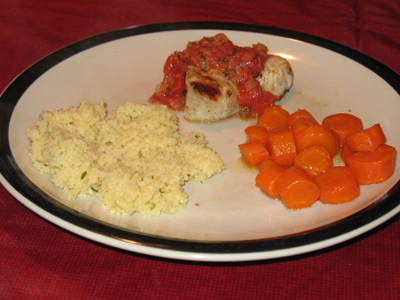This is one of those weeks where I just didn’t feel like buying meat. Thing is, we stockpile over the course of the year – a buy-one-get-one-free deal (BOGO) here, a trip to BJ’s there, and there’s just MEAT in the freezer. And, when dh started to explain how we’re just overspending on our grocery bill, I couldn’t stomach the thought of putting out money for fresh meat when I knew we had stuff in the freezer that was just in need of a thaw. And that’s where the salmon comes in. Being that we’re on a sustainable seafood kick that we are trying to make a lifestyle choice, we’d purchased a pair of frozen sockeye salmon packages on a BOGO a few months ago. (The price was decent as a BOGO. Under normal circumstances, it would be overpaying – something like $11.99 for 12oz, which works out to $15.99/lb). We’d grilled the first package not long after getting it, and we found it…dry. Something about it just didn’t work and we attributed this to the fact that it was frozen. DH was highly skeptical that we could make it work, so he’d been leery about my trying something else with the frozen salmon, but I promised that I would do something on the stove that I thought might add some more moisture.
Now, layer into this the fact that the kids don’t really get into meat much, unless it’s a fish stick/square (ds) or a chicken nugget (dd). Neither one really is big into salmon, so I had an uphill battle to climb. I’ll give away the ending: they still didn’t like it. BUT, I was able to get out of dd that the issue wasn’t the preparation but the fact that it was salmon. She just isn’t into salmon in any form. DH and I, on the other hand, liked how this turned out. And, he liked it enough that it convinced him I should go back later this week and pick up more (it’s on a BOGO again), not only so we have it for this recipe but also so that he can make this lovely Salmon Stroganoff that’s in the On Rice cookbook we have. (We’ve made it before with fresh salmon, and this preparation showed him that the frozen would work, too.)
We served this salmon on soba noodles, for a change of pace, and I roasted some golden beets to have on the side. That’s the thing about the CSA – before I started that, I don’t think you’d ever hear me exclaim “OMG! These golden beets are *GORGEOUS*!”, and yet I did that very thing this afternoon. Score one for locally produced veggies and an adult willingness to open one’s mind (and palate) to things that, as a kid, seemed oogy from any distance.
Note: the only mod suggested by dh was that the next time we should include shallots, to add even more sweetness. If you want to add shallots, I’d recommend 1 large shallot, peeled and minced, going in the pan at the same time as the salmon (or even just before).
Prep Time: 5 mins (assuming thawed salmon)
Cooking Time: 25 mins
Serves: 2
Ingredients
12 oz sockeye salmon fillets
1/2 cup white cooking wine (divided)
1-2 Tb olive oil
2 tsp crystallized ginger
1 Tb honey (preferably wildflower)
Make it Happen
1. Remove the skin from the salmon and cut the salmon into pieces no more than 1″ x 1-1/2″.
2. Heat a non-stick skillet over medium heat; add the olive oil to the pan.
3. Add the salmon to the pan and turn to ensure even cooking after about 2 mins.
4. Add about 1/4-1/3 cup of the white wine to the pan, to start the poaching process. Let this cook until the liquid is reduced by at least half.
5. Sprinkle the ginger around the salmon and let it cook for another couple of minutes, until the liquid is mostly gone.
6. Add the remainder of the white wine to the pan. Let this go until the liquid is nearly gone.
7. Drizzle the honey over the salmon pieces and toss/turn to coat them evenly. Let this go until the liquid is down to no more than maybe 1 tsp and serve with rice, noodles (pairs nicely with soba!) or the starch of your choice.



